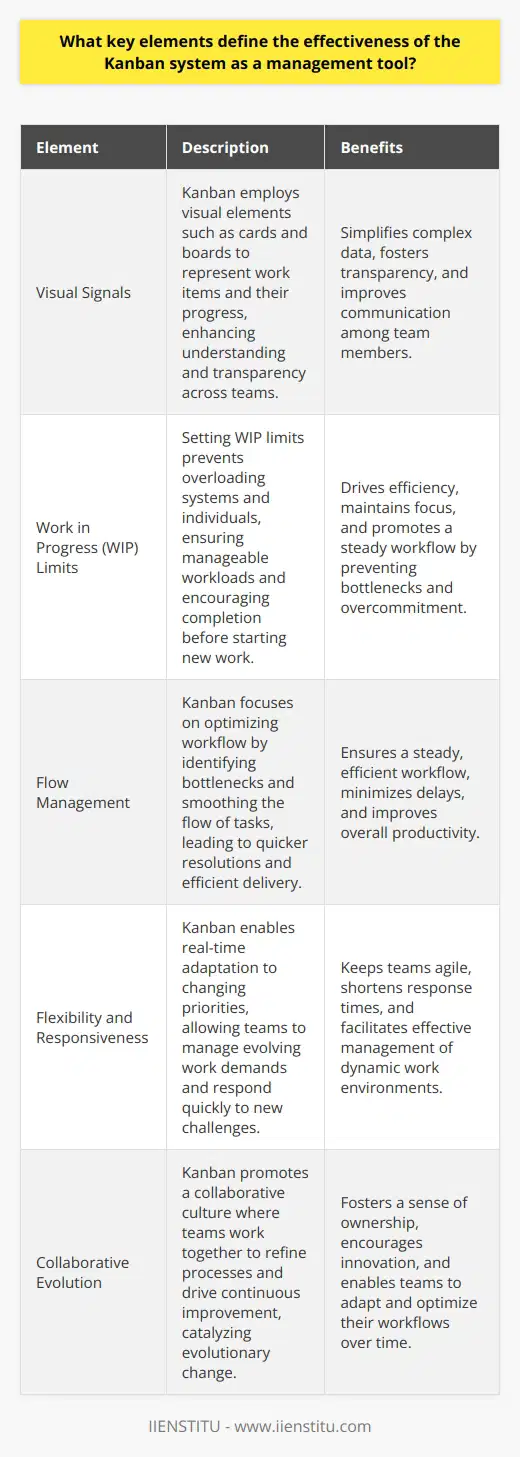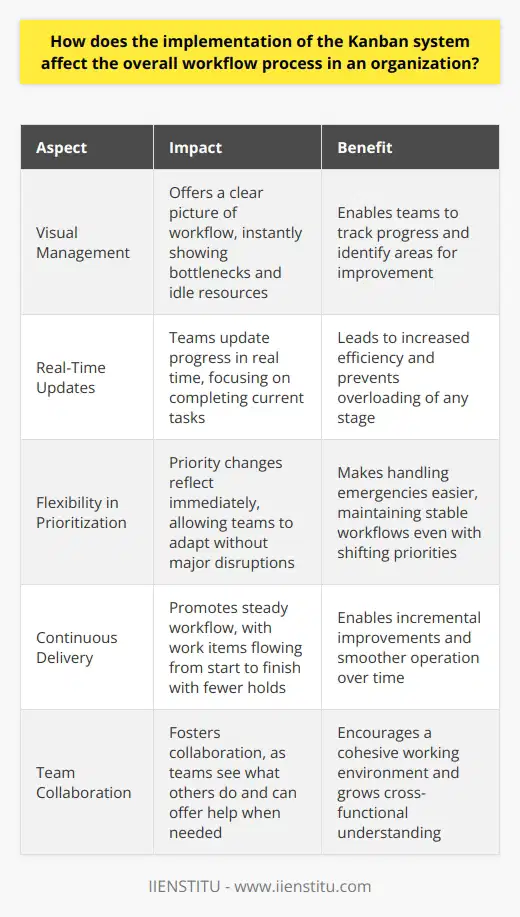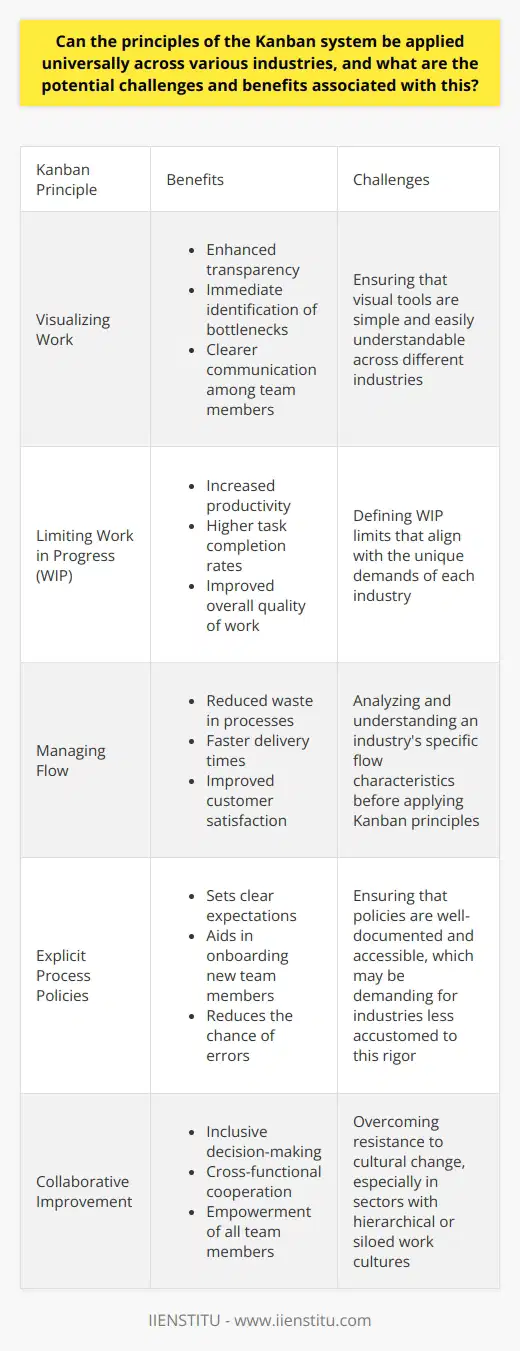
In the realm of productivity and workflow management, the Kanban system has emerged as an efficacious tool that harmonizes the facets of task organization, team synergy, and continuous improvement. Its simplicity in design yet powerful impact on work processes makes it a favored choice among organizations striving for lean management and agile methodologies. The quintessence of this system lies in its ability to offer a visual overview of work status while facilitating a harmonious flow of tasks.
This article delves into the intricacies of the Kanban system, examining its structure, implementation, and the manifold benefits it brings to various domains, substantiated by real-life applications and examples.
Introduction to Kanban System
Definition and Brief Historical Background
The Kanban system, originating from the Japanese word for "signboard" or "billboard," is a methodology designed to manage and improve work across human systems. Conceived by Taiichi Ohno in the automotive industry at Toyota, it has traversed its initial environment and made its mark across numerous sectors. Its primary aim is to align inventory levels with actual consumption, thereby reducing waste and increasing the efficiency of processes.
The system is predicated on visual cues that signal the need to move materials or information within a production process, ultimately fostering a just-in-time manufacturing ethos.
Core Principles and Benefits
Central to the Kanban system are four principal tenets: visualizing the work, limiting work in progress (WIP), managing flow, and enhancing leads to a culture of continuous improvement. By displaying tasks on a Kanban board, team members can get an at-a-glance overview of the project's status, which encourages transparency and collective responsibility.
Limiting WIP prevents overburdening the system and ensures that each task receives adequate attention. The Kanban system is user-oriented as it promotes the management of workflow in alignment with the team's capacity, which culminates in decreasing delivery times, optimizing resource allocation, and facilitating pivot whenever necessary.
The Structure of the Kanban System
Root Cause Tree Analysis: Insights to Forensic Decision Making
Pareto Chart: A Powerful Tool for Data Analysis and Decision-Making
Visualizing the Workflow
Kanban Boards
Perhaps the most recognizable feature of the Kanban system is the Kanban board. It is typically divided into columns representing different stages of the workflow. Each task or work item is represented by a Kanban card that moves through the columns, which could be as simple as "To Do," "In Progress," and "Done." These boards can be either physical or digital, offering a tactile or virtual representation, respectively.
Example of a Simple Workflow Visualization
To illustrate, imagine a software development team that employs a Kanban board to track its progress. The board may have columns for "Backlog," "Analysis," "Development," "Testing," and "Deployment." As the team progresses with their tasks, the corresponding Kanban cards shift from left to right. This simple but effective visual aid contributes to a shared understanding of work progress and highlights any blockages in real-time.
Limiting Work in Progress
Importance for Efficiency
An often underestimated but critical aspect of the Kanban system is its emphasis on limiting WIP. By capping the number of tasks in active progress, the system prevents task overload and ensures each team member can concentrate fully on their current assignments. This focus not only leads to better-quality outcomes but also expedites completion rates.
Real-life Application Example
A marketing team using Kanban might set a WIP limit for each stage of its campaign development process. When the "In Progress" column reaches its maximum capacity, no new work is started until a current task moves to the next stage. This method prevents the team from becoming overwhelmed and maintains a steady, controlled progression of work along the pipeline.
Implementing the Kanban System
Steps in Implementation
Identification of Current Workflows
The initial step in deploying a Kanban system involves a thorough analysis of existing processes. Understanding the workflow is imperative for creating an adequate Kanban board. The current state of operations must be documented and scrutinized to ensure the Kanban board reflects all aspects of the actual workflow.
Introduction of Kanban Principles
Following this, the core principles of the Kanban system are to be slowly integrated into daily operations. This gradual introduction supports team adaptation and acceptance while allowing for the calibration of the system to the team's specific needs.
Continual Adjustment and Monitoring Process
Kanban is an empirical control method; thus, regular reviews and adaptations of the process are mandatory. The system is tailored to foster a learning environment where each retrospective brings about potential improvements. Monitoring key metrics like lead times and cycle times helps in evaluating the system's impact and guides further optimizations.
Tools Used for Kanban Implementation
Online Applications and Platforms
In the digital age, several online certificate courses offer comprehensive knowledge and problem-solving skills training in the principles and application of Kanban. Teams can implement the system using a variety of platforms and applications designed to streamline the Kanban process. These tools provide customizable boards, analytics, and integration with other systems, making the transition smooth and maintaining the integrity of the methodology in a digital environment.
Physical Tools for Smaller Teams
While digital tools are pervasive, physical Kanban boards are equally effective, particularly within small teams or co-located environments. They offer a tangible, collaborative tool that team members can interact with, fostering a sense of collective effort and progress that virtual tools may not replicate as convincingly.
Benefits of the Kanban System in Different Settings
Kanban in Project Management
Increasing Efficiency in Project Delivery
Project management is one sphere where Kanban has demonstrated substantial efficacy. Its visualization promotes clarity, whereas limiting WIP and managing flow can markedly enhance efficiency in project delivery. Team members remain cognizant of deadlines and priorities, contributing to a concerted effort towards project completion.
Case Study Example
In a case study involving an IT firm, the implementation of a Kanban system resulted in a 25% improvement in project completion times. By clearly delineating responsibilities and utilizing a visual workflow, the firm was able to streamline its processes, reduce bottlenecks, and enhance cross-functional collaboration.
Kanban in Manufacturing
Reduction of Waste and Idle Time
The roots of Kanban in manufacturing cannot be understated. Here, it is a potent mechanism for reducing waste and idle time. Through signaling and pulling inventory only as needed, organizations can significantly cut down on excess production, thus aligning output more closely with demand.
Industrial Application Example
For example, in a manufacturing plant, the introduction of a Kanban system can transform the supply chain process. By aligning parts replenishment with actual usage, the company can minimize inventory levels, thus cutting down on storage costs and reducing the risk of overproduction.
Common Challenges and Solutions in Implementing Kanban
Recognizing Bottlenecks
A frequently encountered challenge during the Kanban implementation is the identification and resolution of bottlenecks. These impasses can inhibit flow and delay delivery. Kanban makes these bottlenecks visible, prompting proactive management and resolution.
Handling Expectations and Resistance to Change
Change is often met with resistance in any organization. Introducing a new system such as Kanban necessitates managing expectations and addressing the concerns of stakeholders. Effective communication and inclusive training sessions can allay fears and build support for the change.
Steps to Overcome Challenges
To conquer these challenges, organizations must adopt a meticulous approach that includes upfront planning, ongoing support, and the engagement of all team members. Gathering feedback and fostering a culture that embraces continuous improvement are also critical factors for success.
Summarizing the Importance of the Kanban System
The Kanban system stands as a testament to the power of visualization in workflow management, coupled with the principles of limiting WIP and managing flow. Its adaptability across different industries exhibits its universal applicability and its potency in enhancing productivity, improving efficiency, and fostering a culture of continuous improvement.
Invitation to Apply and Explore Kanban Further
Organizations seeking to optimize their operations and individuals aiming to refine their management capabilities are encouraged to apply and further explore the Kanban system. Through dedicated practice and exploration of its principles, Kanban holds the potential to revolutionize the way work is approached and accomplished. With a multitude of resources available, including problem-solving skills training and online certificate courses, the journey to mastering Kanban can be both enlightening and transformative.
Frequently Asked Questions
What key elements define the effectiveness of the Kanban system as a management tool?
Understanding Kanban
The Kanban system stands as a pivotal management tool. Its origins lie in lean manufacturing. Today, it applies widely in project management. Specifically, it aids in visualizing workflow.
Key Elements of Kanban's Effectiveness
Visual Signals
Kanban uses visual elements. These elements include cards and boards. They represent work items and their progress. Visual signals enhance understanding. They simplify complex data. They also foster transparency across teams.
Work in Progress Limits
Setting work in progress (WIP) limits is crucial. They prevent overloading systems and individuals. WIP limits ensure manageable workloads. They encourage completion before new work starts. They drive efficiency.
Flow Management
Kanban focuses on workflow optimization. It aims to smooth the flow of tasks. This focus helps identify bottlenecks. Flow management leads to quicker resolutions. It ensures a steady, efficient workflow.
Flexibility and Responsiveness
Flexibility defines Kanban's real-time adaptation. As priorities shift, Kanban adapts quickly. This adaptability helps in managing changing work demands. It makes response times shorter. It keeps teams agile.
Feedback Loops
Regular feedback loops are core to Kanban. They involve team meetings and discussions. Feedback refines processes. It uncovers improvement opportunities. Adaptations follow these reflective practices.
Collaborative Evolution
Kanban fosters a collaborative culture. Teams work together to refine the system. Continuous improvement is the goal. It does not prescribe; it catalyzes evolution.
Empowered Teams
Kanban empowers team members. It promotes autonomy within established guidelines. Team members pull work as capacity allows. This empowerment boosts morale and engagement.
Customer Focus
Customer satisfaction remains a key element. Kanban responds to client needs. It emphasizes delivering value. Happy customers mean successful management.
Conclusion
These elements underpin Kanban's effectiveness. As a management tool, it strives for continuous improvement. It aligns teams towards common goals. It delivers outcomes with efficiency and agility. The key is not just implementing Kanban. Success lies in embracing its principles.

How does the implementation of the Kanban system affect the overall workflow process in an organization?
Introduction to Kanban
Kanban stands as a popular workflow management method. Organizations adopt it to improve processes. Unlike traditional methods, it visualizes work. This visualization aids in tracking progress. Teams can see work status at any time.
Visual Management
Kanban uses a board and cards. Each card represents a work item. The board displays workflow stages. Teams move cards across the board. This offers a clear picture of workflow. It instantly shows bottlenecks and idle resources.
Real-Time Updates
With Kanban, teams update progress in real time. Work-in-progress limits apply. They prevent overloading of any stage. Teams focus on completing current tasks. This leads to increased efficiency.
Flexibility in Prioritization
Kanban offers flexibility in task management. Priority changes reflect immediately. Teams adapt without major disruptions. This makes handling emergencies easier. Workflows remain stable even with shifting priorities.
Continuous Delivery
Kanban promotes steady workflow. Work items flow from start to finish with fewer holds. Continuous delivery becomes possible. Teams strive for incremental improvements. The goal is smoother operation over time.
Limiting Work in Progress
A key principle is limiting work in progress. This helps maintain focus. It reduces the time to complete items. Stress on teams lessens. Overall throughput increases.
Quality Improvement
With focus comes quality. Fewer concurrent tasks mean fewer mistakes. Quality checks integrate into workflows. Defect rates decline. Customer satisfaction likely improves.
Team Collaboration
Kanban fosters collaboration. Teams see what others do. They can offer help when needed. Cross-functional understanding grows. This encourages a cohesive working environment.
Empowered Team Members
Team autonomy increases with Kanban. Members choose tasks aligning with priorities. They manage their own workload. Empowerment leads to higher engagement.
Feedback Loop
Kanban includes regular reviews. These meetings provide feedback. Teams learn from past performance. They adapt their processes accordingly. Continuous improvement is the result.
Lead Time Reduction
Kanban typically reduces lead times. Visualization helps identify delays. Swift action can follow. Products and services deliver faster.
Enhancing Customer Focus
Customer needs drive Kanban workflows. Teams prioritize based on customer value. As a result, customer satisfaction may rise. Customer-centric approaches take hold.
Flexibility and Responsiveness
Kanban systems adapt quickly. They respond to changing demands. Market shifts don't disrupt operations greatly. This flexibility gives a competitive edge.
Conclusion
The Kanban system transforms workflows. It shifts the focus to visual management. Teams gain insight into their work. Productivity and quality often rise. Collaboration and customer focus sharpen. Organizations notice smoother, more responsive operations. Kanban fosters a sustainable pace of work. It leads to better outcomes for teams and customers alike.

Can the principles of the Kanban system be applied universally across various industries, and what are the potential challenges and benefits associated with this?
Kanban, a lean manufacturing approach, traces its origins to Toyota's production system. Its core principles aim to optimize workflow and efficiency across operations. Given its versatility, experts often discuss its universal applicability. Could industries as diverse as healthcare, software development, and education benefit from Kanban's methodologies? Delving into this reveals both potential and hurdles.
Universal Applicability of Kanban Principles
Kanban revolves around several core principles. These include visualizing work, limiting work in progress, managing flow, making process policies explicit, implementing feedback loops, and collaborative or experimental evolution.
Visualizing Work
Visual management is at Kanban's heart. It allows for real-time observation of workflow and tasks. This transcends industry boundaries. Key benefits lie in:
- Enhanced transparency
- Immediate identification of bottlenecks
- Clearer communication among team members
Any industry can employ simple visual tools. A typical example, the Kanban board, provides a powerful overview of progress without industry-specific confines. Thus, its implementation can see benefits in any setting with tasks and workflows.
Limiting Work in Progress
The practice of limiting work in progress (WIP) facilitates focus and reduces multitasking. Most industries suffer from overburdening teams, leading to delays and quality issues. By constraining WIP, teams can concentrate on completing tasks, thereby boosting:
- Productivity
- Task completion rates
- Overall quality of work
Still, WIP limits must align with the unique demands of each industry. Flexibility in defining these limits is crucial for success across varied contexts.
Managing Flow
Maintaining a steady workflow is essential. Kanban encourages monitoring and optimizing this flow. It aims to reduce cycle time and increase delivery predictability. Industries with project-based work can see marked benefits. These include:
- Reduced waste in processes
- Snappier delivery times
- Improved customer satisfaction
Nevertheless, the challenge here lies in carefully analyzing and understanding an industry's flow characteristics before applying Kanban principles. Each sector has its peculiarities when it comes to workflow.
Explicit Process Policies
Clear policies foster a better understanding of work and workflow. Kanban insists on defining process policies to avoid confusion. This is beneficial as:
- It sets expectations
- It aids in onboarding new team members
- It lessens the chance of errors
However, the challenge arises in ensuring that policies are well-documented and accessible. Industries less accustomed to this rigor may find this principle demanding.
Feedback Loops
Feedback loops are key for continuous improvement, a concept Kanban espouses vehemently. Regular feedback contributes to:
- Quicker issue resolution
- Enhanced learning for teams
- Continuous process improvement
Industries would need to customize feedback mechanisms for their own environments, a challenge that calls for thoughtful strategy.
Collaborative Improvement
Kanban calls for iterative changes made in a collaborative fashion. This drives ongoing improvements and fosters a culture of collective responsibility. The principles encourage:
- Inclusive decision-making
- Cross-functional cooperation
- Empowerment of all team members
This principle, while universally beneficial, requires a shift in organizational culture, which could be a significant barrier in some sectors.
Potential Challenges in Cross-Industry Application
The adaptation of Kanban across industries isn't without its challenges. These can include:
- Resistance to cultural change
- Misalignment with traditional metrics
- Varied levels of complexity in tasks
- Fluctuating demand patterns
Industries ingrained with hierarchical or siloed work cultures may find Kanban's emphasis on collaboration and empowerment difficult to implement. Additionally, traditional metrics may not reflect the efficiencies Kanban brings, making it hard to quantify success in familiar terms.
Conclusion
Kanban's principles certainly hold the potential for universal application. They offer extensive benefits such as improved efficiency, higher quality outputs, and enhanced satisfaction among customers and teams alike. Yet, customizing and overcoming industry-specific challenges are pivotal steps to unlock these advantages. Careful consideration and commitment to the methodology's core tenets can triumph over hindrances, yielding rewards across any sector.



